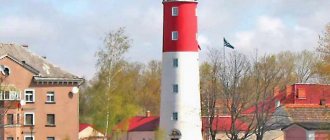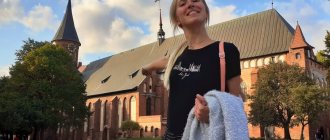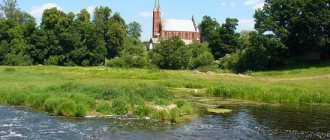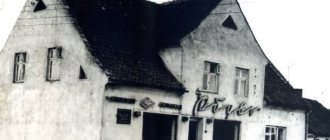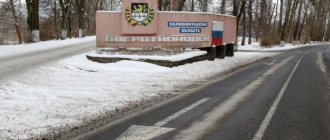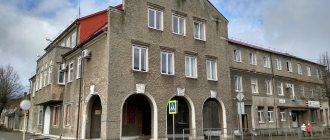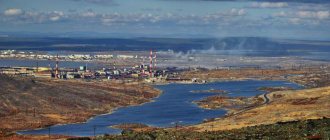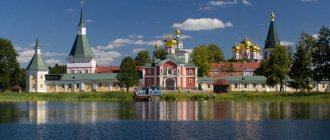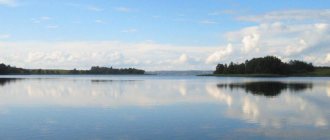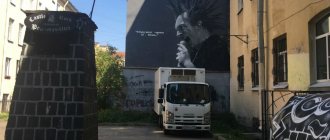Kaliningrad region is the 43rd region of the Russian Federation. It is located in the extreme west of the country, completely separated from the rest of the constituent entities of the Russian Federation by the territories of other states (Lithuania in the north and east, Poland in the south). In the west and southwest it is washed by the waters of the Baltic Sea and the Curonian and Kaliningrad Lagoons included in it. It is part of the Northwestern Federal District.
The area of the Kaliningrad region is 15.1 thousand km2. The length of the border with the Republic of Lithuania is 280.5 km, with the Republic of Poland - 231.98 km. The length of the Baltic coastline is 183.56 km. The Kaliningrad region is one of the smallest territories in Russia, but in terms of population density (63 people per square kilometer) among the territories and regions, it ranks third and is second only to the Krasnodar Territory and the Tula region.
The population of the Kaliningrad region is 1,018,624 people (according to data from the Federal State Statistics Service). The administrative center is the city of Kaliningrad (formerly Koenigsberg - founded in 1255). The nearest regional center of Russia is Pskov, located 800 km from Kaliningrad, 800 km from Kaliningrad, and 1289 km from Moscow from Kaliningrad.
Kaliningrad is connected to the open sea by a shipping canal built at the beginning of the 20th century. The Kaliningrad port is the only ice-free port on the Baltic Sea.
The longest rivers in the region: Pregolya - 123 km, Neman - 115 km.
The largest lake is Vishtynetskoye - 18 square meters. kilometers. The highest altitude above sea level is the Vishtynets Upland, 242 meters.
Large cities in the region:
- Sovetsk (formerly Tilsit)
- Chernyakhovsk (formerly Insterburg)
- Baltiysk (formerly Pillau)
- Gusev (formerly Gumbinen)
The region includes 22 urban districts. The urban population makes up 77.7% of the total population.
Sights of the Kaliningrad region
As for attractions, there are plenty of them in the region. Europe, Germany in particular, left a huge mark. Prussian houses with parks, ancient fortresses have been preserved everywhere, and Catholic churches in some areas are more common than Orthodox ones. Each city has two names, German and Russian.
The sights of the Kaliningrad region are mainly concentrated in the capital of the region - Kaliningrad. There are many museums to suit every taste, architectural and historical monuments, and cultural sites.
What holiday is it today?
February 10, 2022, Thursday
Today are holidays, events: Diplomat's Day Tomorrow: World Sick Day Discovery of insulin
Today is the Orthodox holiday: St. Ephraim the Syrian. Venerable Ephraim of Novotorzhsky. Venerable Ephraim of Pechersk, Bishop of Pereyaslavl. Venerable Theodosius of Totem, Spasosumorin of the monastery, leader and founder... Tomorrow: Transfer of the relics of the holy martyr Ignatius the God-Bearer. Saints Gerasim, Pitirim, Jonah, bishops of Great Perm, Ustva...
Today is a national holiday: Ephraim's Day... Tomorrow: Lawrence's Day
Seasons
Seasons, four periods of the year (spring, summer, autumn and winter) characterized by certain average temperatures. The period during which the Sun passes through one of these sectors is called the season. Spring in the Northern Hemisphere and autumn in the Southern Hemisphere begin when the Sun passes through the initial circle of declination and its right ascension is 0° (vernal equinox). Summer in the Northern Hemisphere and winter in the Southern Hemisphere occur when the sun's right ascension is 90° (summer solstice). Autumn in the Northern Hemisphere and spring in the Southern Hemisphere begin when the sun's right ascension is 180° (autumnal equinox). The beginning of winter in the Northern Hemisphere and summer in the Southern Hemisphere is considered to be the winter solstice, when the direct ascension of the Sun is 270°... Next: Seasons. Russian folk calendar. Monthly words...
Fishing village in Kaliningrad
From Kant Island you will inevitably end up in the Fishing Village - a tourist quarter on the waterfront with many restaurants and cafes. The complex was built in 2005, to celebrate the 750th anniversary of Königsberg-Kaliningrad, and became another hallmark of the city. In November 2022, the New Kaliningrad Synagogue was opened here, built in the image of the Königsberg Synagogue, destroyed during World War II.
Every hour, excursion ships leave from the pier in Fishing Village. While walking along Pregola you can learn the history of Kaliningrad and see the impressive ships in the port. After midnight, active life in the Fishing Village stops.
On the opposite bank from the Fishing Village there is an unfinished and abandoned House of Soviets, which can be seen from many points in the city. Its construction stopped in the second half of the 80s, and since then the building has been empty and deteriorating. It is prohibited to be on the territory of the House of Soviets, but extreme sports enthusiasts took secret excursions there for some time, bribing the guards. In November 2022, the regional governor admitted that the building cannot be restored and they plan to dismantle it.
Read more about this House of Soviets and the Royal Königsberg Castle, on the site of which it was built, in a separate article.
And not far from Rybnaya Village there is the newest attraction - the Kaliningrad stadium, built for the 18 FIFA World Cup.
There are beautiful well-groomed embankments leading to it, which are pleasant to stroll along in sunny weather.
Folk calendar about every day
Every day one season always replaces another and this determines a person’s way of life. In connection with this, a folk calendar was formed in which there were practically no nameless, unmarked days. Every day was special, had its own purpose. All this was determined by climate conditions and astrological phenomena.
A calendar is a system for counting periods of time. The first calendars arose a long time ago, in ancient times, because there was a need to measure time. The word calendar comes from the Latin words caleo - to proclaim and calendarium - debt book. This is due to the fact that in Ancient Rome the beginning of each month was especially proclaimed, and because it was customary to pay debts on the first day of the month. Different peoples counted time differently. Some calendars are based on the changing phases of the moon - lunar calendars; in others - the change of seasons - sunny; in others, the length of the year was coordinated with the change of seasons, and the counting of months was associated with the phases of the Moon. Such calendars are called lunisolar.
In Rus', the calendar was called a monthly calendar. Every day, the month book covered the entire year of peasant life, “describing” day by day, month after month, where each day had its own holidays or weekdays, customs and superstitions, traditions and rituals, natural signs and phenomena. The cyclical nature of the calendar is reminiscent of human life, where spring is youth, summer is heyday, autumn is the time of harvesting fruits (it’s good if there are some, otherwise you can live your life without collecting fruits), winter is the time of wisdom and peace. This cyclicality and rhythm determined the way of life of the farmer. The folk calendar was an agricultural calendar, which was reflected in the names of the months, folk signs, rituals and customs. Even the determination of the timing and duration of the seasons is associated with real climatic conditions. Hence the discrepancy between the names of the months in different areas... Next: Folk calendar...
Baltic Spit
The spit stretches for 65 km, it can be considered the westernmost point of Russia. It is located between two bays - Kaliningrad and Gdansk. This is an area of white dunes covered with forest.
The spit is connected to the mainland only on the territory of a neighboring state. From the Russian coast you can get here by ferry. In good weather it leaves Baltiysk every 2 hours.
On the spit you can admire beautiful landscape views, visit the ruins of a former German air base, and see the ruins of the Western Fort. Upon returning to Baltiysk, you can get acquainted with the monuments and visit the museums of the city.
Village Yantarny
A small village, known primarily for the fact that 90% of the world's amber reserves are concentrated here. Palmniken (the former name of Yantarny) arose in the 17th century around the first amber deposit. The entire subsequent history of the village is connected with its extraction. Today Yantarny is also known for its beach, the first in Russia (in 2016) to receive the status international Blue Flag award. In Yantarny there is a beautiful wooden promenade stretching along the coast for 2 kilometers. Part of it passes over a picturesque lake among sand dunes.
In Yantarny you will visit the only quarry in the world where amber is mined, look at the stars from a bridge in the middle of the lake on the sea coast, and more.
Where to eat: from May to September there are beach cafes along the entire coastline of Yantarny, the most popular of which is “Cactus”. In the off-season you can eat at the Basil pizzeria (Sovetskaya, 110 v).
Where to stay in Yantarny: a five-star hotel with an elegant restaurant, a hotel with an equestrian center, a mini-hotel with Anna baths.
The oldest tree in the Kaliningrad region
In the former Prussian city of Ludwigsort (present-day Ladushkin) at 10 Pobedy Street, a unique tree has survived to this day. This is a huge giant oak tree, the age of which even scientists cannot accurately determine.
The size of the tree growing on the territory of the former cheese factory is simply impressive - at a height of one and a half meters its diameter reaches 8.7 m, and the circumference of the trunk at the base is more than 13 m. This giant spreads its crown over 40 m.
Casino Sobranie
The Kaliningrad region is one of four Russian gambling zones, so the Sobranie casino with a bar and several restaurants operates legally here.
It is located near the village of Kulikovo, on the coast of the Baltic Sea. The journey from Kaliningrad takes approximately 45 minutes. The casino has slot machines, roulettes and tables. In addition, behind the casino building there is a descent to the sea, which leads to a beautiful deserted beach. A passport or other ID is required to enter the casino.
Fishing calendar for every day
The fishing calendar should not be taken as an absolutely indisputable truth. Fish biting is greatly influenced by a whole range of natural factors, as well as the influence on the nature of man himself. You must not forget that the fish’s bite depends and is determined not only by the calendar dates and biological cycles of their life, reflected in the calendar, but also, no less, by the state of their habitat; the bite also depends on weather conditions: air and water temperatures, cloudiness, wind direction and strength, etc... Next: Fishing calendar...
Standard of living in the Kaliningrad region: pros and cons
Today, the Russian Government pays a lot of attention to this area, investing budget funds to diversify industries and improve the area. A sum is allocated for the restoration of roads, monuments, castles, German towns, and resort areas. At the same time, the tourism sector is rapidly developing and infrastructure is being updated. A big bonus for the Kaliningrad region is access to the Baltic Sea.
The standard of living is still inferior to cities with a million population, but the dynamics are improving. The population is gradually growing, wages are increasing, and local prices are gradually coming into line.
In 2022, the cost of living in the region is 13,153 rubles. per able-bodied person, and the cost of living is within 51,425 rubles. for a family of two. This is slightly higher than in larger regions - Novosibirsk, Sverdlovsk, Krasnodar. The average salary is 35,855 rubles.
pros
Whether it is better to live in the Kaliningrad region or not can be judged by the reviews of those who have moved. They are often called advantages:
- Climatic features – marine and temperate continental climate. Enough warmth in summer. Minimal precipitation in winter. Thanks to rain and humidity, there is a lot of vegetation in a rich green hue. There are no sharp temperature changes between seasons, which is why residents are less likely to suffer from colds.
- Beach holidays - on the Baltic Sea, Kaliningrad, Gdansk and Curonian Lagoons. Availability of equipped embankments for promenades, summer cafes, entertainment for adults and children. There are hotels, guest houses, boarding houses, sanatoriums, and SPA centers for any budget.
- Clean air and absence of heat with dry periods create a comfortable living environment for asthmatics and allergy sufferers.
- Well-developed cultural and social life in the region. Festive concerts and themed events are regularly held. A sufficient number of establishments for a pleasant stay: coffee shops, nightclubs, cinemas, theaters, bowling alleys.
- Shopping available in Europe. Most often they go to Poland for food, furniture, and clothes. It is believed that the goods are cheaper and of better quality.
Orthodox calendar about every day
Orthodox calendar: Orthodox, Church and Christian holidays.
The church year is an alternation of weekdays and holidays. On weekdays, a person is called to work “by the sweat of his brow to earn his bread.” Holidays are given in order to feel liberation, to rise above the bustle and routine of the world, to feel involved in the highest of worlds, “where there are no illnesses, sorrows and sighs, but endless life.” Since ancient times, holiday cycles have been associated with the seasons. The pagans associated them with the worship of the forces of nature, the cult of which in the Old Testament was replaced by gratitude to the Creator for the universe. And although the connection between holidays and the seasons has not completely lost its power, since God is present in everything, in the plant and animal world, in human works, it nevertheless faded into the background, giving way to a spiritual foundation built on the Sacred Scriptures. The history of Orthodox holidays dates back to the times of the Old Testament. Each of the Orthodox holidays is dedicated to the remembrance of the most important events in the life of Jesus Christ and the Mother of God, as well as the memory of saints... Next: Orthodox calendar...
Curonian Spit
One of the main attractions of the Kaliningrad region, included in the UNESCO World Heritage List. The border between Russia and Lithuania runs in the middle of the spit.
There are three villages on the Russian side:
- Lesnoy (closest to Zelenogradsk),
- Fishing
- Marine.
The most developed tourist infrastructure is in Lesnoy, although most people go to Kos to escape from civilization and be alone with nature.
Deserted places can be found here even in high season.
Main attractions on the Curonian Spit:
- Dancing Forest (trees with unusual trunks that inexplicably bend in space);
- height of Efa
- ornithological station (Spit is a natural migration route for birds; here they are ringed and their behavior is studied).
Where to eat: the choice of establishments is small. There are several cafes and restaurants in the villages of Lesnoy and Rybachy. In Rybachye you can also buy smoked fish. Someone praises the restaurant LAS Promenade OZ in Lesnoy (Vzmorya, 1), but this is just a restaurant. You can go to the exquisite Altrimo in Rybachy (Pogranichnaya, 11), also a restaurant.
Where to stay on the Curonian Spit: hotel "" with a cozy restaurant, glamping (approximately open from May to October), tourist complex (chalets and rooms, there are places for tents), numerous sanatoriums and boarding houses.
Russian folk calendar for every day
The word “sign” comes from the word “notice”, i.e. observe. As a result of observing what happens around a person every day, he accumulates life experience. This knowledge was passed down from generation to generation, carefully preserved and people trusted it as a sacred book. Many signs have come to us from the depths of centuries without losing their knowledge. Each of us is free to choose: to dismiss all this as an absurd superstition or to take a closer look at the signs and take the centuries-old experience of generations more seriously. Most of us, when taking exams, ask them to scold them, boasting about some kind of good fortune or luck, spit so as not to jinx them or knock on wood, take a detour if a black cat crossed the road, are afraid of the number 13 and much more. And who among us does not have lucky things, numbers? Who has never resorted to the help of fate at least once in their life, who has not believed in secrets? It’s as if everything connected with signs is hidden somewhere deep in our subconscious. Often we remember them mechanically, unconsciously, or just as a joke. But, undoubtedly, the signs contain a lot of accurate knowledge and practical wisdom of our ancestors. They cover all the characteristic, often difficult to perceive, natural phenomena. Signs have preserved a lot of what was in old folk holidays and customs; they help predict the weather, grow crops... Next: Folk signs...
Holiday calendar, dates and events of the year
All state and professional holidays in Russia, including significant World and International holidays, and other equally interesting holidays and events about every day.
The holiday has always kept pace with the history of mankind. Social time can be divided into three types: everyday life (weekdays), weekends and holidays. Everyday life is a series of practices repeated day after day and every day (work). Weekends are regular breaks from the rush of everyday life. It is believed that on weekends a person should restore his strength after working days. Day off, non-working day. A holiday is a day of celebration established in honor or in memory of someone or something. A day or series of days celebrated by the church in memory of a religious event or saint... Next: Calendar...
Prayer book, Orthodox prayers for every day
Prayer is the most powerful means for healing all illnesses - both physical and mental. Prayers can be laudatory or grateful, petitionary and repentant. If we have offended God, sinned, we must ask Him for forgiveness, that is, repent. Such prayers are called repentant prayers. If everything is fine with us, if we and our loved ones are healthy and prosperous, if we have a place to live, something to wear, something to eat, we must glorify and thank God for this. Such prayers are called praise or thanksgiving. If some misfortune, illness, trouble or need happens, you need to ask God for help. Such prayers are called petitionary... Next: Orthodox prayers...
Zodiac, astrological, eastern calendar. Zodiac signs
In ancient times, to establish the calendar, priests used knowledge of the positions of all the planets. Before the reform of Peter 1, the New Year was celebrated on the Day of the Autumn Equinox. On this day, according to ancient legend, the most peaceful treaty was concluded between the Great Race (ancient Slavs) and the Great Dragon (ancient Chinese) and it was approximately 7518 years ago... For the ancient Slavs, the calendar month corresponded to the lunar cycle from new moon to new moon, taking into account such Thus, the relationship of the entire annual cycle with astronomical and natural phenomena. There was no coherent calendar system. The main natural phenomena are still considered to this day to be the days of the solar equinox and solstice - the Slavic holidays Maslenitsa, Kupala, Ovsen and Kolyada. But during the time of Peter 1, all ancient Slavic calendars were abolished and a new Western European calendar from the Nativity of Christ (Julian calendar) was introduced, while the beginning of the calendar was moved to January 1. The Julian calendar (old style) did not take leap days into account and accumulated one extra day every 128 years. After the October Revolution in 1918, the Gregorian calendar (new style) was introduced in Russia, according to which an amendment of 13 days was introduced. The calendar of the ancient Slavs was based on two planets: the Sun and the Moon. And now they don’t use anything at all. The calendar has become static. There is no such thing as the calendar, it turns out, resting on some planet. Nobody even knows about it. There are just some standard numbers, there are months and holidays. The calendar is based on the Sun and Moon. Why is this so? Because these two luminaries influence the Earth. The Earth revolves around the Sun, and the Moon revolves around the Earth. And these two luminaries create the atmosphere on the planet. From here the calendar is built... Next: Astrological calendar...
Luisenallee and Amalienau district
Once you've finished exploring the defenses or skipped them, head north to Central Park. It has existed since the end of the 18th century. Queen Louise of Prussia (1776–1810) loved to visit this place. At the beginning of the 20th century, her grandson, German Kaiser Wilhelm II (1859–1941), built a church here in memory of Queen Louise (today there is a puppet theater in the church). The park has rides and one of the city's Ferris wheels.
The areas around the park suffered less damage during the war, so here you can feel the atmosphere of pre-war Königsberg. At the end of the 19th century, a fashion arose in the city for measured country life in small elegant villas with balconies, bay windows and turrets. Examples of architecture from this era can be seen on Luisenallee, which was named after Queen Louise and is now called Komsomolskaya Street). The street stretches exactly from south to north and divides two historical districts of old Königsberg: Amalienau and Mittel Hufen.
Richly decorated apartment buildings of the late 19th - early 20th centuries are concentrated on Komsomolskaya. Amalienau is the territory of delightful ancient villas, where all the most important buildings can be seen by walking along the route Central Park (CPKiO) - Kutuzova Street - Chestnut Alley - Pobedy Avenue - Borodinskaya Street - Pushkin Street.
On Kutuzov Street attract attention:
- romantic villa Makowski (Kutuzova, 7) and located opposite the villa “Rural House Ruth” (Kutuzova,
 with a high mansard roof and shutters on the windows.
with a high mansard roof and shutters on the windows. - the villas of Yafa (Kutuzova, 10) and Schmidt Jr. (Marina Raskova, 23) in Belorussky Square are two of the most striking monuments of the late modern era (1909–1911).
Villa Michaelis (corner of Kutuzov and Ogarev) is an example of the decorative modernist movement, which was embodied in numerous stucco decorations and complex forms of the mansion.
At the next intersection is Villa Winter (Chestnut Alley, 26-28) - the largest mansion in Amalienau.
The route then leads to Amalienau's most grandiose and impressive mansion, Villa Leo (Chestnut Alley 16), created in 1902 for city councilor and shipping company owner Ludwig Leo.
Villa Leo
Next door is the Schmidt Sr. Villa (24 Pobeda Avenue), built in 1903–1904 for the founder of the water production company, Eduard Schmidt. The brick building with a high gable became the pride of its owner, as evidenced by the inscription “My house is my pride!” on one of the elegant bas-reliefs.
Villa Honkamp (17 Pobedy Avenue) with its light semicircular veranda gives the impression of a cozy little palace surrounded by a garden.
Many interesting pre-war buildings can be seen while walking along the picturesque streets of Admiralskaya, Pugachev, Minin and Pozharsky in the Amalienau area.
Dream books online, interpretation of dreams
A dream book is nothing more than an interpreter of dreams and dreams, a translator of dreams. Since ancient times, people have been using dream books; dreams have always been given great importance, and people have often noticed the prophetic properties of some dreams. The dream book can become your faithful assistant every day and throughout your life, thanks to the dream interpreter you can always make the right decisions, the dream book will help you resist temptations in time, and will warn you against wrong steps and frivolous actions. Further…
